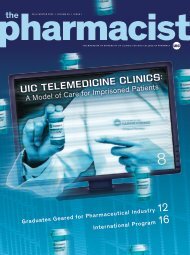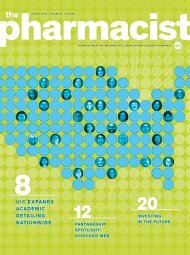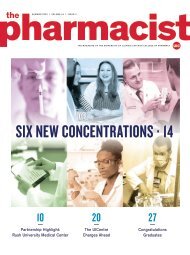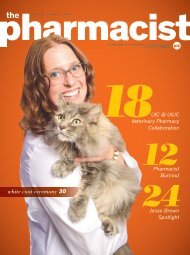The Pharmacist / Spring 2022 / Volume 44 / Issue 2
Magazine of the University of Illinois Chicago College of Pharmacy
Magazine of the University of Illinois Chicago College of Pharmacy
You also want an ePaper? Increase the reach of your titles
YUMPU automatically turns print PDFs into web optimized ePapers that Google loves.
Dr. Soojin Jun is a<br />
board-certified geriatric<br />
pharmacist in Illinois and<br />
Wisconsin. She is also a<br />
certified professional in<br />
patient safety (CPPS) and<br />
a certified professional in<br />
healthcare quality (CPHQ).<br />
After losing her dad to<br />
many gaps in healthcare<br />
as a minority caregiver,<br />
one of them a medication<br />
adverse event, she<br />
changed her career from<br />
a wedding videographer<br />
to a pharmacist. Currently,<br />
she works as an inpatient<br />
pharmacist and also a<br />
Salk Health Activist fellow<br />
at Jewish Healthcare<br />
Foundation. She is a<br />
cofounder of Patients for<br />
Patient Safety U.S., a group<br />
of patient safety activists<br />
who are committed to<br />
activating U.S. healthcare<br />
according to the Global<br />
Patient Safety Action Plan<br />
2021–2030 of the World<br />
Health Organization. She<br />
specializes in medication<br />
therapy management<br />
and believes empathy<br />
in healthcare can make<br />
healing possible in any<br />
relationship of healthcare.<br />
She has experience in both<br />
inpatient and outpatient<br />
pharmacies and has<br />
worked as a population<br />
health pharmacist for heart<br />
failure patients. She is also<br />
an ambassador for the<br />
Patient Safety Movement<br />
Foundation, a nonprofit<br />
organization dedicated to<br />
patient safety worldwide.<br />
She passionately speaks<br />
up about patient safety,<br />
patient rights, health equity,<br />
the expansion of roles of<br />
pharmacists in public health<br />
and policy, and patient<br />
advocacy for voiceless<br />
patients.<br />
Three Reasons Why Recognizing<br />
<strong>Pharmacist</strong>s as Providers Can Help Solve<br />
Public Health Crisis in the United States<br />
Here are three ways pharmacists can help address the two most<br />
pressing problems of healthcare in the United States.<br />
BY SOOJIN JUN, PHARMD ’13, BCGP, CPPS, CPHQ<br />
After losing my dad to medical gaps and adverse<br />
events from medications as a minority patient, I<br />
decided to change careers and went from being a<br />
videographer to being a pharmacist. Through my naive<br />
yet passionate endeavor, I thought I could improve<br />
healthcare one patient at a time. I was so eager for<br />
change that I created a business plan with my friends<br />
for a pharmacist-mediated digital health solution that<br />
would allow patients and caregivers to coordinate care<br />
together with doctors and hospitals, an idea directly<br />
inspired by my personal experience as a caregiver<br />
before graduation.<br />
I interacted with entrepreneurs from StartUp Health,<br />
PillPack, and incubator 1871 (now Matter) as well<br />
as venture capitalists and competed in different<br />
competitions, including South by Southwest. I enrolled<br />
in the health informatics graduate program to make the<br />
app a possibility with a targeted clinical trial for minority<br />
patients in mind. I could not continue after I became<br />
pregnant with my third child, but I gained valuable<br />
lessons and observations from this experience.<br />
<strong>The</strong>re were not many pharmacists in the middle of this<br />
innovation movement and conversation because we<br />
could not bill as providers; innovators did not look to<br />
pharmacists, with whom they could and should partner, to<br />
bring changes.<br />
At the time there was a petition going around started<br />
by Sandra Leal, now the president of the American<br />
<strong>Pharmacist</strong>s Association (APhA), asking for federal<br />
recognition of pharmacists as providers under Medicare.<br />
I decided to help spread the word with another<br />
student in Texas, Steve Soman. We created<br />
a Facebook page, “Recognize <strong>Pharmacist</strong>s<br />
as Providers,” and posted the efforts on<br />
the Facebook pages of other colleges<br />
of pharmacy. <strong>The</strong> original Change.org<br />
petition was moved to the White House<br />
petition site, gained traction, and<br />
received a response as promised after<br />
reaching the target of 25,000 under<br />
the administration of Barack Obama.<br />
Although federal recognition was<br />
not achieved and the response was<br />
far from what we were looking for,<br />
it created a conversation. California became the first<br />
state to recognize pharmacists as providers in 2013.<br />
Since then, we have 37 states recognizing pharmacists<br />
as providers. However, lack of federal recognition still<br />
slows innovation that we desperately need, especially<br />
in cutting costs and optimizing therapies for chronic<br />
illnesses. I know billions of dollars are often attributed<br />
to a lack of “compliance” with medications. To me, this<br />
is a tunnel-visioned estimate of the cost. (By the way,<br />
patient advocates cringe over that word, compliance, so<br />
if your organization claims to be patient-centric, please<br />
consider avoiding the word.)<br />
<strong>The</strong> first and foremost value of recognizing pharmacists<br />
as providers is that we can help deprescribing<br />
medications and guide patients to healthier lives for<br />
many chronic illnesses. Many insurance and government<br />
sponsored programs are wasting money by “restricting”<br />
how pharmacists should practice under their laws and<br />
regulations when they can better use the time and money<br />
by “guiding” how pharmacists could practice as providers.<br />
<strong>The</strong>re are many pharmacists who are burnt out of<br />
practicing in the boxed set of rules that clearly do not<br />
bring the real results we want to see in patients. Many<br />
functional medicine pharmacists who look at patients as<br />
a whole, for example, have created their own practices.<br />
However, because pharmacists are not providers in<br />
many states, the results pharmacists can bring are more<br />
regional than widespread. With telehealth and digital<br />
health tools, this is changing. Still, too many barriers<br />
continue exist for pharmacists.<br />
<strong>The</strong> second equally important value of<br />
recognizing pharmacists as providers<br />
is that we can guard patient safety<br />
more effectively. Traditionally,<br />
nurses and doctors have been in<br />
the main roles of patient safety<br />
and still are. However, as Lucian<br />
Leape, the renowned father of<br />
the patient safety movement,<br />
had written in his published<br />
paper, pharmacists’<br />
participation in intensive<br />
care unit rounds<br />
reduced medical<br />
22 THE PHARMACIST PHARMACY.UIC.EDU








